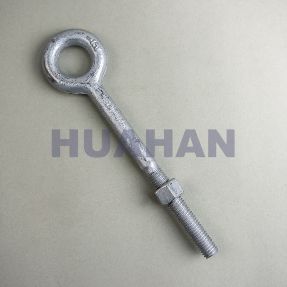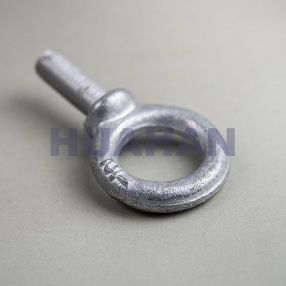1410, PARKSON, 44-60 ZHONGSHAN ROAD, QINGDAO, CHINA
Types of Eye Bolts
Used as a lifting or securement point, eye bolts are one of the most popular types of rigging hardware. Just like slings, sling hooks, and shackles, eye bolts come in a number of different designs and configurations. Eye bolts can be used as a connection point for rigging, anchoring, pulling, pushing, or hoisting applications.
Shouldered Eye Bolts
 Shouldered eye bolts are also commonly referred to as “shoulder pattern” eye bolts. These eye bolts are designed with a shoulder at the point where the eye and the shank come together. This shoulder design reduces bending stresses on the shank and allows the eye bolt to be used for angular lifting if the shoulder is properly seated in the load.
Shouldered eye bolts are also commonly referred to as “shoulder pattern” eye bolts. These eye bolts are designed with a shoulder at the point where the eye and the shank come together. This shoulder design reduces bending stresses on the shank and allows the eye bolt to be used for angular lifting if the shoulder is properly seated in the load.
When used for sideloading or angular loading, you must ensure that the shoulder is completely flush to function properly. Always follow the manufacturer’s specifications and reduction in capacity based on the different angles of loading.
If you are lifting with slings at ANY angle, you must use a shouldered eye bolt.
Non-Shouldered Eye Bolts

Non-shouldered eye bolts are also commonly referred to as “plain pattern” eye bolts. Designed without a shoulder, they can only be used for truly vertical or in-line lifts. Non-shouldered eye bolts are not designed for or intended to be used for, any type of side loading or angular loading.
Shouldered Eye Bolts vs. Non-Shouldered Eye Bolts
When selecting the proper eye bolt for your application, one of the most important considerations is whether you need a shouldered or non-shouldered (plain pattern) eye bolt. A shouldered eye bolt can be used for vertical in-line lifts or for angular lifts. Non-shouldered eye bolts should be used for in-line or vertical lifts only and should NEVER be used for angular lifts.
Forged Eye Bolts

Forged eye bolts are hammered or pressed into form, which changes the grain structure of the metal to create a stronger, harder, and more durable product. Forged eye bolts are useful for heavier-duty lifting applications as they’re significantly stronger than wire eyes, can withstand loads up to the tensile strength of the material they’re made from and are available in larger sizes.
When equipped with a shoulder, forged eye bolts can be used for in-line or angular loading.
Bent Eye Bolts
Also referred to as turned eye or wire eye bolts, these eye bolts are made from one piece that is bent and shaped to form the eye.
Bent eye bolts are used primarily for lighter-duty applications and should not be used for heavy loads, which can cause the eye to open, or for angular loads, which can bend or break the bolt.

When Using Eyebolts Always:
· Store and handle eyebolts correctly.
· Inspect eyebolts before use and before placing into storage.
· Select the correct pattern eyebolt for the application.
· Ensure that the eyebolt and tapped hole threads are compatible and strong enough for the load.
· Correctly align the plane of the eye using shims where necessary.
· Ensure that the collar is fully seated when hand tight.

When Using Eyebolts Never:
· Use tommy bars, grips or wrenches to tighten eyebolts.
· Use dynamo eyebolts for angular loading.
· Use a single eyebolt to lift a load that is free to rotate.
· Reeve slings through the eyes, links or shackles fitted to pairs of eyebolts.
· Force hooks or other fittings into the eye; they must fit freely.
· Shock load eyebolts.
o Type of eyebolt - eyebolt with link for all general purpose applications, collar eyebolt for most general duties, dynamo eyebolt only where a truly axial load is guaranteed. (A collar eyebolt fitted with a link through the eye must always be considered as a collar eyebolt and not as an eyebolt with link.)
o Capacity - (rating eyebolts for angular loading) It is necessary to reduce the SWL by the following factors when using eyebolts with two leg slings:
o Never return damaged eyebolts to storage. They should be dry, clean and protected from corrosion. Care must be taken to protect threads from damage whilst in store.
o Where possible use removable plugs to exclude debris from tapped holes.
o Do not attempt lifting operations unless you understand the use and limitations to use of the equipment, the slinging procedures and the mode factors to be applied.
o Do not use defective eyebolts. Check the thread of both the eyebolt and hole, ensure they are compatible, fully formed, of sufficient length, undamaged and clear of any debris which may prevent proper engagement.
o Ensure the contact surface around the hole is flat, clean and perpendicular to the thread axis. Tighten the eyebolt down firmly by hand. The eye must be in the correct plane and the collar must sit evenly on the contact surface. Use shims but do not machine the collar or over tighten to achieve this.
o A hook may be engaged directly into the eye of a dynamo eyebolt or the link of an eyebolt with link. Collar eyebolts must be fitted with a shackle or link to accept hooks. The hooks must fit freely so do not wedge or force them into position.
o Never reeve a sling through the eyes, links or shackles fitted to eyebolts used in pairs as this will impose a severe resultant load to the eyebolts.
o Dynamo eyebolts must only be used for axial loading. When using eyebolts with multi-leg slings use eyebolts with links or collar eyebolts taking care to de-rate them correctly for angular loading conditions.
o Where a single eyebolt is used, use a swivel or swivel hook to prevent the eyebolt unscrewing.
Find more information about Eye Bolts :
https://www.huahanmachinery.com/eyebolts01.html